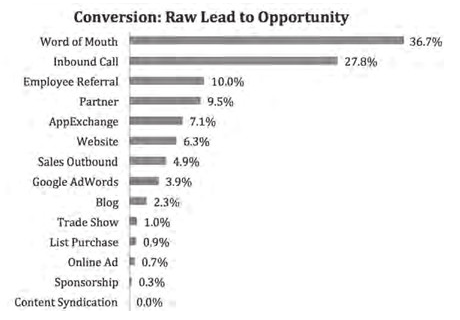Some will tell you that a lead is a lead is a lead. That is especially the case in early stage startups where it is hard to get anyone to notice, much less respond. In this state of desperation, it can be easy to fall head over heels for any prospect that returns a call or responds to an email. How awesome it is that you got the attention of a real buyer! But just like the dangers of falling in love too quickly, often these short term romances turn sour. You see, not all leads are the same, and not every lead is deserving of your love.
Leads can come in all sorts of shapes and sizes and directions. Some common examples include:
- Purchased lists
- Social media
- Tradeshows and events
- Inbound website traffic
- Outbound calling
- Email marketing
- Partners
- Referrals
- Word of mouth
These are all valid lead sources, and each can have the potential to generate solid opportunities. There are a lot of sources however, so the challenge becomes determining which sources provide the biggest bang for the buck and how to best prioritize one’s limited time.
If the above chart is any indication*, there are some pretty wide ranging degrees of success when converting leads when measuring by lead source. Word of mouth and referrals are far and away better sources than tradeshows and social media (at least in the case of Marketo, where this chart originated from).
While this will differ based on industry and business model (for example, social media might be much more important for a mobile consumer app), the point is that some lead sources produce significantly more gold than others.
What this means is that you must treat leads differently based on the source, score these leads according to importance/priority and capture this information in a system. There is no logical reason for a highly paid sales rep (or in the case of a very early startup, the CEO) to call or email website leads in most cases. That should be the job of a marketing intern or assistant. Likewise, referrals and inbound calls would be better worth the time of the sales people. By using a simple scoring mechanism, you can more easily distribute the work to focus time on the high quality leads while still nurturing other, less urgent leads. The point is that with limited resources, time is the most precious resource, so it pays to build your early lead generation and sales processes with efficiency in mind.
Besides scoring each lead however, it is imperative that you capture the lead source. How else are you going to understand what lead generation programs and marketing activities are providing the best return on investment? With limited dollars, you can ill afford to spend cash on events and other pricey programs without clearly understanding the return. And you cannot know what that return is without tracking leads with rigor, and that includes capturing lead source and tying that back to lead scoring, lead-to-opportunity conversions and eventually closed revenue.
At this point, you may be asking yourself whether this is even worthwhile. A lot of startups generally get early leads through existing connections and referrals within the founders’ networks. However few leads you may be receiving though, it is good to get into the practice of rigorously capturing and measuring leads, as it will provide the basis of your lead generation programs later on. Still, you are probably scratching your head as to how to find enough leads to be picky or to build any sort of “program.” While the above list is a good start at some sources to mine, how does one even start? That is what we will talk about next time as we learn how to “prime the pump” to get our lead generation activities kick started.
* From the book Predictable Revenue by Aaron Ross and Marylou Tyler.
This article was originally published on Strong Opinions, a blog by Birch Ventures for the NYC tech startup community.





